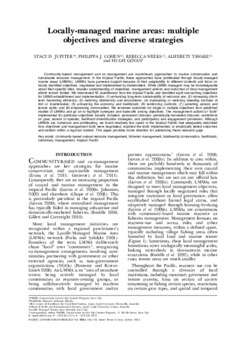Locally-managed marine areas: multiple objectives and diverse strategies

Citation
Jupiter, S.D. et al. (2014). Locally-managed marine areas: multiple objectives and diverse strategies. Pacific Conservation Biology, 20(2): 165-179
Community-based management and co-management are mainstream approaches to marine conservation and sustainable resource management. In the tropical Pacific, these approaches have proliferated through the spread of locally-managed marine areas (LMMAs). LMMAs have garnered support because they can be adapted to different contexts and focus on locally identified objectives, negotiated and implemented by the people involved. While LMMA managers may be knowledgeable about their specific sites, broader understanding of objectives, management actions and outcomes of local management efforts remain limited. We interviewed 50 practitioners from the tropical Pacific and identified eight overarching objectives for LMMA establishment: (1) enhancing long-term sustainability of resource use; (2) increasing short-term harvesting efficiency; (3) restoring biodiversity and ecosystems; (4) maintaining or restoring breeding biomass of fish or invertebrates; (5) enhancing the economy and livelihoods; (6) reinforcing customs; (7) asserting access and tenure rights; and (8) empowering communities. We reviewed outcomes for single or multiple objectives from published studies of LMMAs, with the intent to highlight synergies and trade-offs among objectives. The management actions or 'tools' implemented for particular objectives broadly included: permanent closures; periodically-harvested closures; restrictions on gear, access or species; livelihood diversification strategies; and processes to enhance participation and engagement of communities. Although LMMAs are numerous and proliferating, we found relatively few cases in the tropical Pacific that adequately described how objectives and management tools were negotiated, reported the tools implemented, or empirically tested outcomes and seldom within a regional context. This paper provides some direction for addressing these research gaps.
Permalink
Date Available
Type
Publisher
Countries
Research Themes